The AMD Trinity Review (A10-4600M): A New Hope
by Jarred Walton on May 15, 2012 12:00 AM ESTAMD Trinity General Performance
Starting as usual with our general performance assessment, we’ve got several Futuremark benchmarks along with Cinebench and x264 HD encoding. The latter two focus specifically on stressing the CPU while PCMarks will cover most areas of system performance (including a large emphasis on storage) and 3DMarks will give us a hint at graphics performance. First up, PCMark 7 and Vantage:
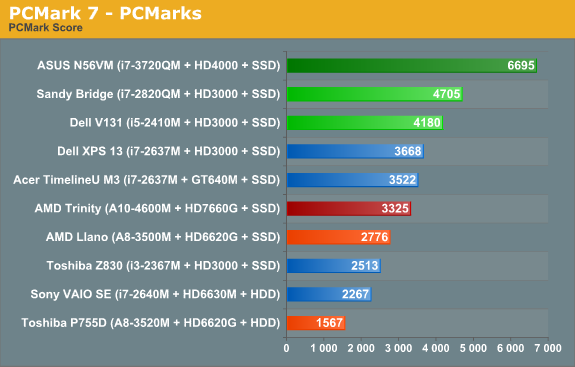
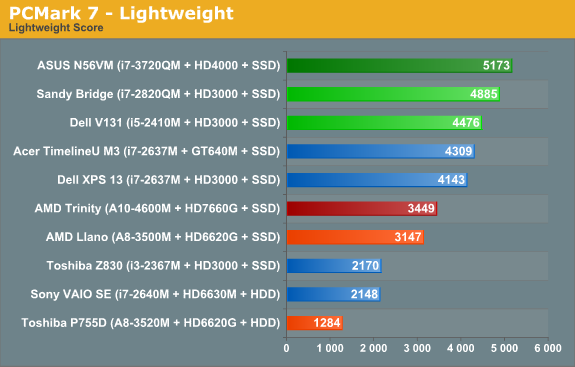
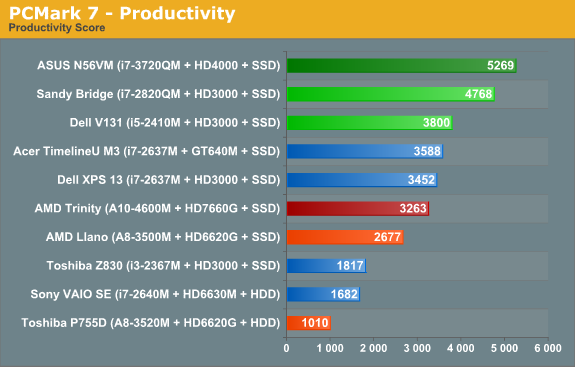
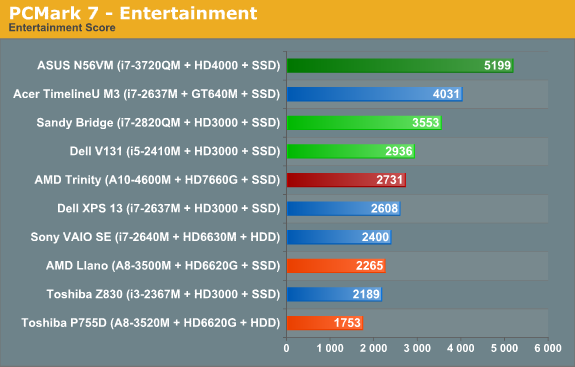
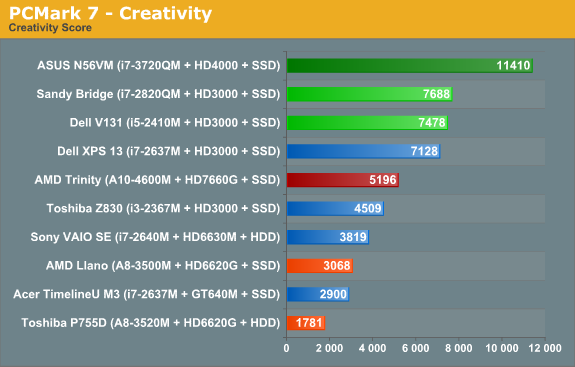
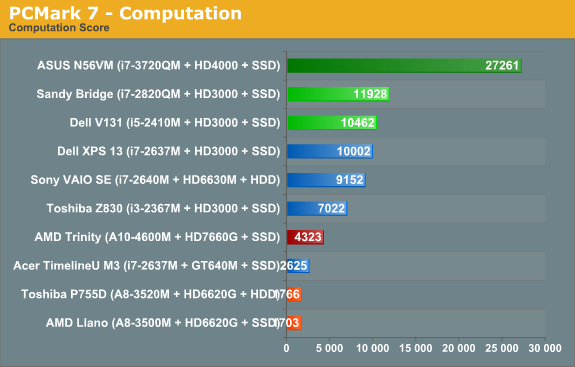
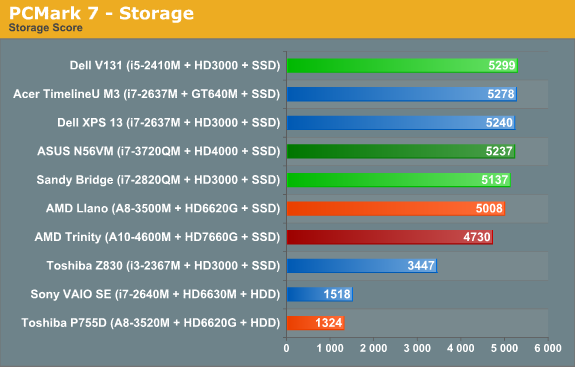
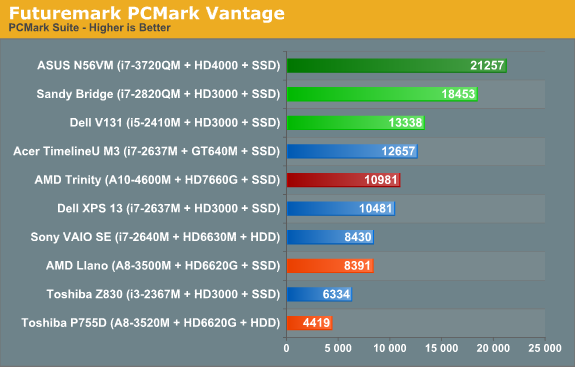
As noted earlier, we ran several other laptops through PCMark 7 and PCMark Vantage testing using the same Intel 520 240GB SSD, plus all the ultrabooks come with SSDs. That removes the SSD as a factor from most of the PCMark comparisons, leaving the rest of the platform to sink or swim on its own. And just how does AMD Trinity do here? Honestly, it’s not too bad, despite positioning within the charts.
Obviously, Intel’s quad-core Ivy Bridge is a beast when it comes to performance, but it’s a 45W beast that costs over $300 just for the CPU. We’ll have to wait for dual-core Ivy Bridge to see exactly how Intel’s latest stacks up against AMD, but if you remember the Llano vs. Sandy Bridge comparisons it looks like we’re in for more of the same. Intel continues to offer superior CPU performance, and even their Sandy Bridge ULV processors can often surpass Llano and Trinity. In the overall PCMark 7 metric, Trinity ends up being 20% faster than a Llano A8-3500M laptop, while Intel’s midrange i5-2410M posts a similar 25% lead on Trinity. Outside of the SSD, we’d expect Trinity and the Vostro V131 to both sell for around $600 as equipped.
A 25% lead for Intel is pretty big, but what you don’t necessarily get from the charts is that for many users, it just doesn’t matter. I know plenty of people using older Core 2 Duo (and even a few Core Duo!) laptops, and for general office tasks and Internet surfing they’re fine. Llano was already faster in general use than Core 2 Duo and Athlon X2 class hardware, and it delivered great battery life. Trinity boosts performance and [spoiler alert!] battery life, so it’s a net win. If you’re looking for a mobile workstation or something to do some hardcore gaming, Trinity won’t cut it—you’d want a quad-core Intel CPU for the former, and something with a discrete GPU for the latter—but for everything else, we’re in the very broad category known as “good enough”.
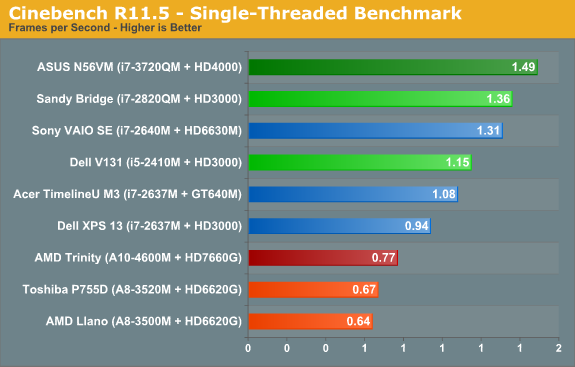
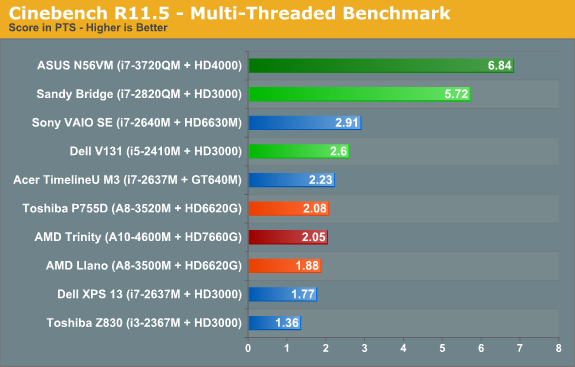
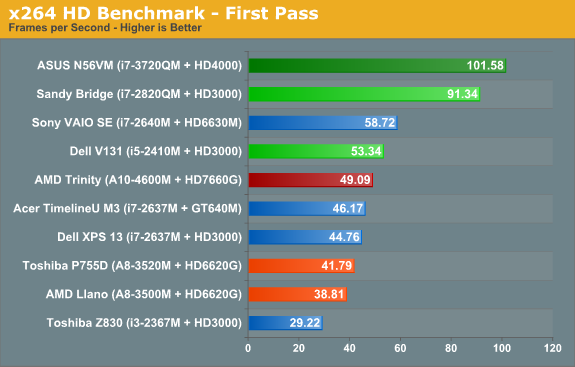

When we start drilling down into other performance metrics, AMD’s CPU performance deficiency becomes pretty obvious. The Cinebench single-threaded score is up 15% from 35W Llano, but in a bit of a surprise the multi-threaded score is basically a wash. Turn to the x264 HD encoding test however and Trinity once again shows a decent 15% improvement over Llano. Against Sandy Bridge and Ivy Bridge, though? AMD’s Trinity doesn’t stand a chance: i5-2410M is 50% faster in single-threaded Cinebench, 27% faster in multi-threaded, and 5-10% faster in x264. It’s a good thing 99.99% of laptop users never actually run applications like Cinebench for “real work”, but if you want to do video encoding a 10% increase can be very noticeable.
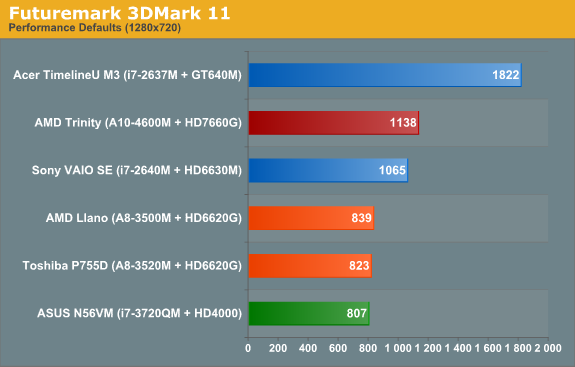
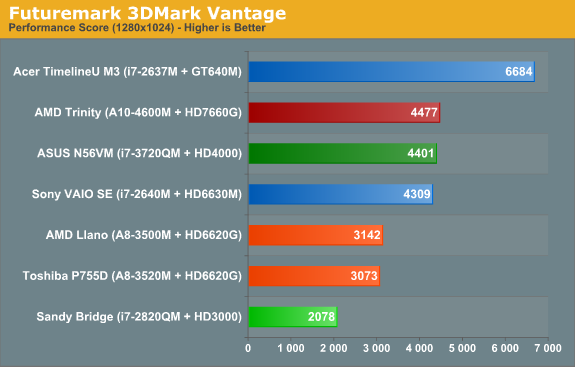
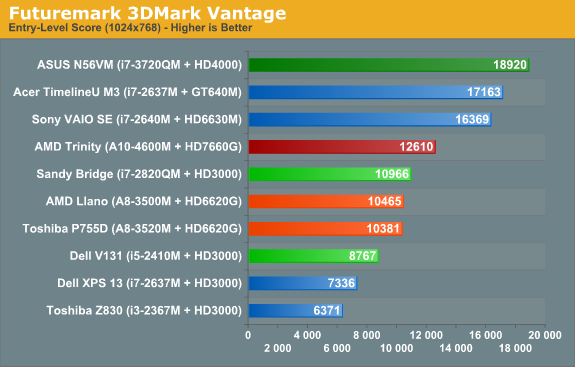
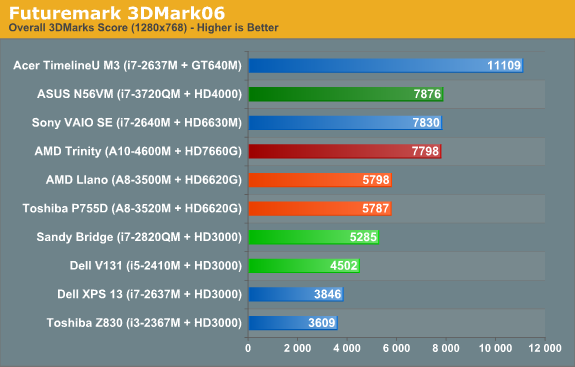
Shift over to graphics oriented benchmarks and the tables turn once again...sort of. Sandy Bridge can’t run 3DMark11, since it only has a DX10 class GPU, but in Vantage Performance and 3DMark06 Trinity is more than twice as fast as HD 3000. Of course, Ivy Bridge’s HD 4000 is the new Intel IGP Sheriff around these parts, and interestingly we see Trinity and i7-3720QM basically tied in these two synthetics. (We’ll just ignore 3DMark Vantage’s Entry benchmark, as it’s so light on graphics quality that we’ve found it doesn’t really stress most GPUs much—even low-end GPUs like HD 3000 score quite well.) We’ll dig into graphics performance more with our gaming benchmarks next.










271 Comments
View All Comments
codedivine - Tuesday, May 15, 2012 - link
Does the GPU support fp64?JarredWalton - Tuesday, May 15, 2012 - link
I would assume so, though like most consumer GPUs it's going to be 1/16 FP32 performance or something similarly dire. If you have a quick test I could run, I'll be happy to report back.codedivine - Tuesday, May 15, 2012 - link
Thanks. Can you post the relevant output from "clinfo.exe"? This utility should either be part of new Catalyst releases, or you can alternately install AMD's APP SDK and it is a prebuilt utility. This will list a lot things, including extensions supported in OpenCL. It will show two devices available: one for CPU and one for GPU. If the GPU side lists cl_khr_fp64 (or the less-compliant cl_amd_fp64) then it supports FP64 in OpenCL.Not sure about how to test the rate.
JarredWalton - Tuesday, May 15, 2012 - link
Both cl_khr_fp64 and cl_amd_fp64 are listed as supported on both the CPU and GPU. Full CLinfo output is available here:http://images.anandtech.com/reviews/mobile/Trinity...
codedivine - Tuesday, May 15, 2012 - link
That is great! Your help is greatly appreciated!So I guess I am buying a Trinity then, as it will simplify my OpenCL development workflow.
Sidenote: I have some OpenCL code under development (as part of my grad research) that might be useful for you for benchmarking purposes for as well. Will get back to you about that in a few weeks.
JarredWalton - Tuesday, May 15, 2012 - link
Cool -- I'd love to see more OpenCL benchmarks, especially if they're actually meaningful to other people!GullLars - Tuesday, May 15, 2012 - link
This may not be relevant, but i think the next generation APU with GCN graphics architecture is where we will really start to see a benefit of using GPGPU on mainstream integrated GPUs.Various GPGPU benchmarks show a signifficant increase going from VLIW4 to GCN.
I hope to get into openCL, GPGPU and parallel programming too at a later point. Currently i'm styding a BS in Computer Engineering; Embedded Systems. I love it, as it gives insight into both software and hardware at all levles from logic gates to complete systems.
Brutalizer - Tuesday, July 10, 2012 - link
WOW! Does the Trinity only have two cores? That is brutal!AMD's version of hyperthreading is a piledriver core: it has duplicated several components which is much better than Intel hyperthreading. So one piledriver core, corresponds to one Intel core with hyper threading.
So, what Anandtech is actually testing, is four Intel core cpus, vs two AMD core cpus. There is no surprise that four cores beats two cores, but the cool thing is that AMD two cores does very well compared to four Intel cores!
If I was AMD, I would say that the Trinity only has two cores, and still it gives a four core Intel cpu a match! That is much better marketing than claiming Trinity is four cores (which is not) and get beaten by Intel four core cpus.
moozoo - Tuesday, May 15, 2012 - link
Thanks!I too was after the CLInfo for trinity to find out its fp64 support.
MySchizoBuddy - Tuesday, May 15, 2012 - link
so it only supports OpenCL 1.1 not the newer 1.2